High-yielding sweet honeysuckle variety Boreal Blizzard
Owners of personal plots, wanting to diversify their collection of plants and try something new, are increasingly paying attention to honeysuckle. Boreal Blizzard is a modern variety with edible berries and a decorative appearance. This unpretentious plant has a number of nuances in agricultural technology that even a beginner can master.
Description of the variety
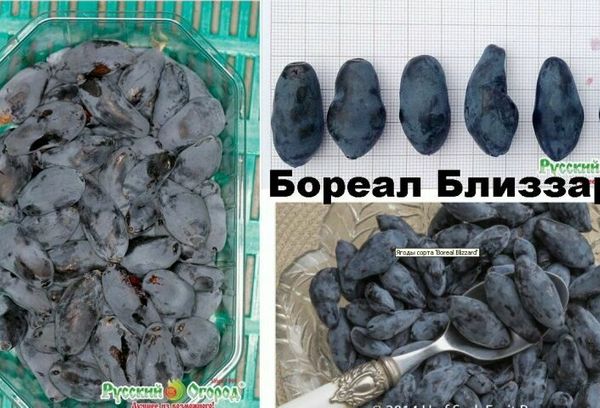
Boreal Blizzard honeysuckle is popular in the USA, Canada, Japan and China, where the largest plantations of this plant in the world are located.
Origin and development, history of breeding
In 1998, Canadian breeders began a project to develop an edible variety of honeysuckle. Japanese and Russian varieties were taken as a basis. As a result, the most resistant to cold weather and the least demanding to care for were selected.
After many years of experimentation, we managed to obtain a series of varieties. One of the most successful is Boreal Blizzard, whose name translates as “Northern Storm”.
Characteristics, description of appearance, taste
The bush grows up to 1.5 m in height, the shoots grow upright, the shape of the crown is spherical and spreading.
The average weight of bluish-inky berries is in the range of 3-4.5 g, the shape is oval, slightly elongated. In size they are classified as large-fruited - length 3-3.5 cm, diameter - 1 cm. The pulp is juicy, dense, the taste is sweet.
Features of the use of this variety
The variety was bred to produce edible berries with high taste.
Productivity and fruiting
Productivity is high, on average 4-5 kg per bush.Ripe berries are firmly attached to the branches and do not fall off.
Ripening period
The variety is late-ripening and begins to bear fruit in the third year after planting. Berry picking occurs in July-early September.
Resistance to diseases and pests
The variety is resistant to powdery mildew. A plant with strong immunity and in the absence of errors in care does not suffer from diseases. Pest infestation occurs if preventive measures are not taken.
Resistance to cold and drought
The bush tolerates frosts down to -40°C without loss. Flowers are not damaged by spring frosts down to –8°C.
Honeysuckle is a moisture-loving plant. Prolonged drought negatively affects its condition.
Read also:
Which regions are best suited and climate requirements?
The variety is suitable for cultivation in northern latitudes, where late flowering is not subject to return frosts. In the southern regions, growing honeysuckle is also possible, since it goes into dormancy late.
The main advantages and disadvantages of the variety
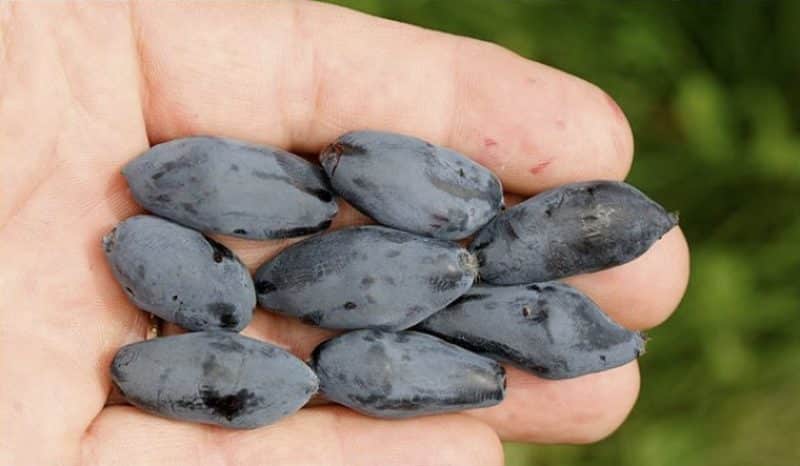
Honeysuckle Boreal Blizzard has the following advantages:
- long fruiting period;
- large and transportable berries with excellent taste;
- the fruits practically do not fall off;
- high frost resistance.
No significant deficiencies were found.
What is the difference from other varieties and hybrids
Possessing a number of undoubted advantages, the variety popularizes honeysuckle as a type of garden plant and expands cultivation regions.
Owners value it for its annual increase in yield; gradual ripening allows the berries to be picked within 3-4 weeks.
Agricultural technology
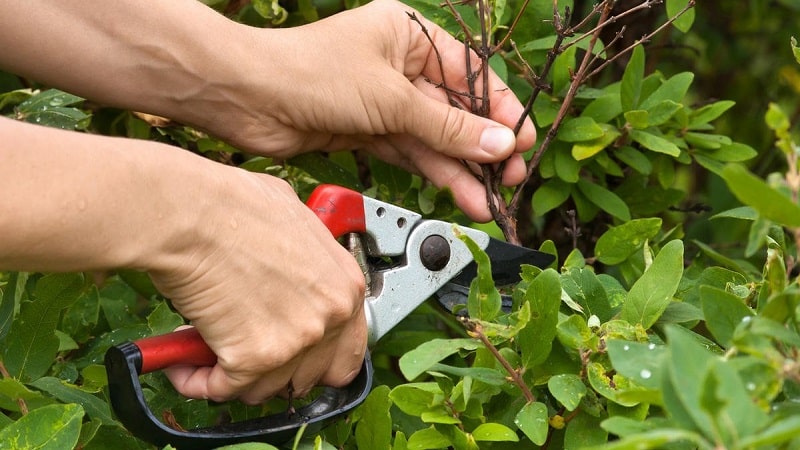
In one place under optimal conditions, honeysuckle grows for 30 years or more.The culture is considered unpretentious, but has a number of growing features.
Choosing a place in the garden and preparing holes
Honeysuckle adapts to a wide range of soils, with an acidity of pH 5-7. Any fertile, moist area with good drainage will do; lowlands and flooded areas are not suitable. The plant requires light throughout the day and protection from northern winds. Planting at a distance of 2-3 m from buildings and other plantings will allow the bush to grow freely and not be in the shade.
The hole is prepared 12-15 days before planting. The depth is 4-5 cm greater than the earthen ball of the seedling. When choosing the diameter of the hole, take into account that the plant needs space for the unhindered growth of the root system. If the groundwater threshold is high, drainage made of broken bricks or small crushed stone is poured onto the bottom.
Preparing for landing
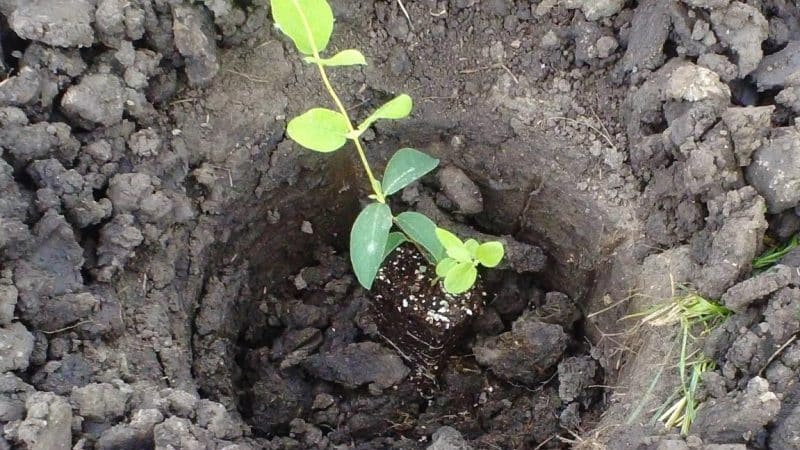
For planting, annual specimens are purchased from nurseries, including rooted cuttings. Signs of the right seedling:
- height 50-150 cm, 2-3 main shoots;
- roots are moist and well developed;
- no damage, cracks, growths or stains.
Before work, bushes with an open root system are shortened with too long shoots and soaked for 3-4 hours in a “Kornevin” solution or just water.
Important! Seedlings in a container do not require treatment; they are planted throughout the season.
Soil requirements
The soil in the future location is prepared in order to ensure easy survival for the plant and a strong start for development. The work includes clearing weeds and adding organic matter, followed by digging. In case of high acidity, lime is added, and high-moor peat helps with alkalization.
Dates, scheme and rules of planting
There are two dates for planting honeysuckle: in spring in April-May and in autumn from September to October.
In spring, the optimal time is at the end of the snow melting, when the ground is saturated with moisture, but has already dried out and warmed up. In autumn, the crop goes into a dormant state and planting proceeds painlessly.
The holes are made at a distance of 1.5-2 m from each other. An interval of 2-3 m is maintained between the rows. The soil from the pits is mixed with 100 g of superphosphate, 30 g of potassium sulfate and a bucket of compost.
Landing rules:
- fill the hole two-thirds with soil mixture, make a mound out of it in the center;
- place a seedling, straighten the roots, the neck is 5 cm below the surface;
- cover with the rest of the soil, compacting it periodically;
- watered and mulched with compost, straw, and mown grass.
A bush in a pot is planted using the transshipment method, without destroying the lump.
Features of cultivation
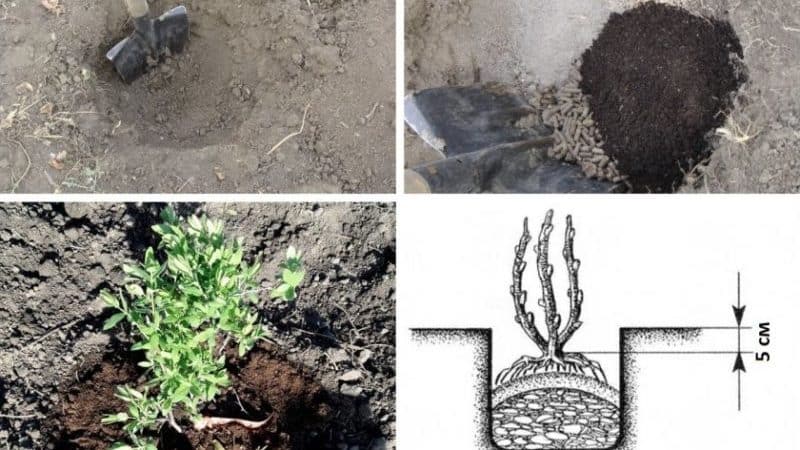
Rooting of honeysuckle occurs within 2-3 years. The plant's energy is spent mainly on the development of roots, so the ground mass grows slowly.
For cultivation in the Siberian climate or close to it, three-year-old seedlings are chosen. The pits are prepared in the spring and planted in the fall, a month before frost. In the southern regions, a place in partial shade is more suitable for the culture.
Nuances of care
The seedling is watered so that the tree trunk does not dry out. Shallow loosening in combination with weeding is mandatory. An adult bush needs 3-4 waterings per season. In the fruiting phase they are temporarily stopped.
Important! In hot weather or drought, increase the volume of water, otherwise the fruits will be bitter and the plant will weaken.
Feeding begins at the age of 3-4 years. In spring, the root zone is mulched with humus and watered with a solution of complex mineral fertilizer with a high nitrogen content.At the beginning of the formation of the ovary, wood ash is buried under the bush, 1-2 foliar feedings are carried out with microelements, for example, urea in a concentration of 5-10 g per 1 liter of water per plant - it improves the quality and size of the fruit.
Before preparing for winter, they are loosened with the addition of superphosphate and potassium salt.
At the age of 6-8 years they begin pruning. In the spring, dry and damaged branches are removed, in the fall - weak, non-fruit-bearing shoots. Anti-aging pruning is required 15-18 years after planting, when 8-10 of the strongest branches are left.
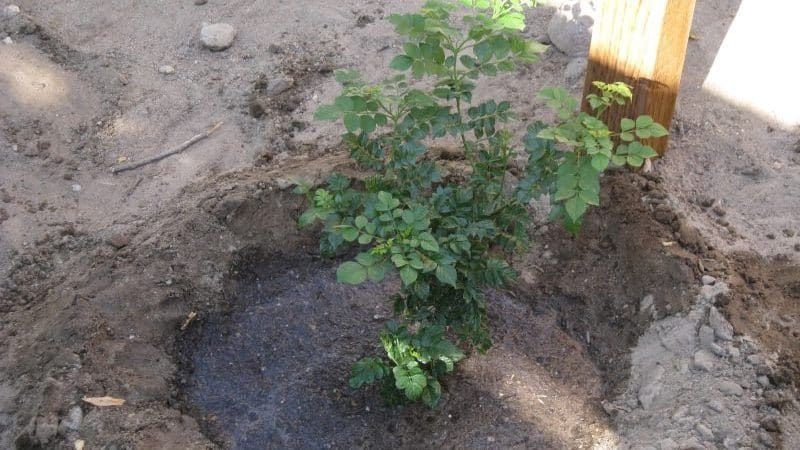
Pollinators
The variety is not self-fertile and requires cross-pollination from companions. On a plot at a distance of no more than 20-25 m, 2-3 bushes of other representatives of the Boreal Beauty (Northern Beauty) or Boreal Beast (Northern Monster) series are planted.
Disease and pest control
Compliance with the rules of agricultural technology minimizes the risk of the development of pathogenic organisms and pests. Problems are caused by errors in care and inappropriate location, prolonged rainfall or drought.
The most aggressive diseases:
- Ramularia - gray-white spots on the foliage in early spring. Then it attacks the stalks and stems.
- Cercospora is a fungus that appears as a brown mark with a red edge. The leaves dry out and die.
- Rezuha mosaic is a virus spread by a nematode or already present in planting material. Causes the growth of deformed leaves from the side axils, due to which the bush thickens and stops development, the shoots weaken and dry out.
- Red-olive blotch is a growth on foliage where fungal spores multiply and survive the winter in the ground when they fall off.
Preventive measures include spring preventive treatment and timely removal of the affected parts of the bush.The drugs “Mancozeb”, “Tiovit”, “Fundazol”, and Bordeaux mixture suppress the reproduction of spores at any stage of development.
The most dangerous pests:
- Leaf roller - rolls leaves and feeds on sap, lays larvae.
- The honeysuckle fingerwing is a fruit-eating caterpillar.
- Aphids - settle in colonies on the underside of leaves, on which yellow-brown spots appear.
- Scale insects - affects the shoots, the fruits are hard and do not ripen.
- The honeysuckle mite is a small sucking parasite; the leaves it eats curl and dry out.
During the season, the bushes are inspected for the presence of pests and areas of infection.
If detected, spray with insecticides at intervals of 15-20 days. “Aktara”, “Aktelik”, “Konfidor”, “Fitoverm” are suitable for culture.
Preparing for winter
Due to its increased winter hardiness, honeysuckle does not require shelter from frost. To be on the safe side in the northern regions, young bushes are additionally mulched with a thick layer of foliage and covered with spruce branches.
Reproduction
Vegetative methods are suitable for propagation.
Cuttings:
- after flowering, the young shoot is cut into pieces 10-15 cm long, so that there are 2-3 buds;
- cut off the lower leaves, plant them in a nutrient substrate, cover them with jars or film;
- keep at a temperature of +25°C, water as it dries and ventilate the greenhouse;
- After rooting and the beginning of growth, they are planted in holes.
Reproduction by layering:
- in June, the soil under the bush is dug up and loosened;
- strong annual shoots from the lower tier are secured to the ground with a wire pin, buried by 5-7 cm;
- water as usual;
- In the spring they are cut off from the bush and replanted.
In autumn, honeysuckle aged 6-7 years is divided and several seedlings are obtained.The bush is dug up and cut into pieces so that each has a pair of shoots. The wounds are covered with garden varnish. Planted using standard technology.
Harvesting
The berries take a long time to ripen, so picking them takes several “approaches.” Maximum yield occurs in 6-7 years.
How and when to collect
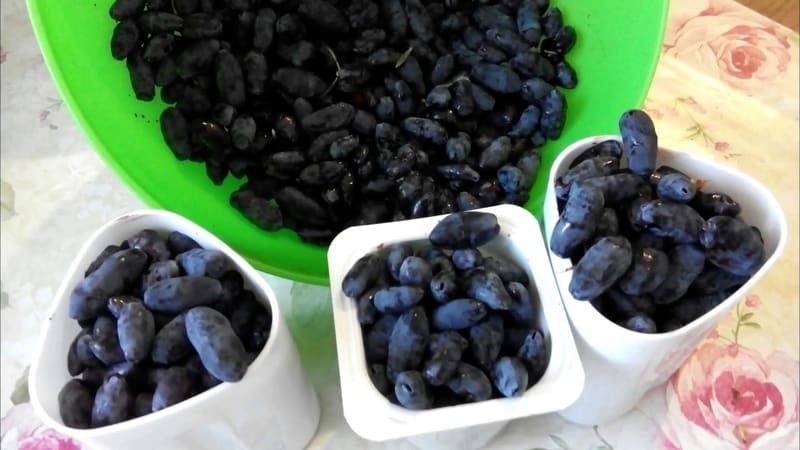
Ripe berries begin to be picked in mid-summer. They are picked without stalks and placed in a shallow container or box. To speed up the process, the method of plucking from the bush is suitable, but these berries are used immediately and are not stored.
The shelf life of honeysuckle in the refrigerator is up to five days. Can be transported over short distances without loss of quality, suitable for freezing and drying.
What difficulties may there be when growing
Sometimes after winter there are cracks in the bark - frost holes. Such branches are cut out in the spring, and the cuts are smeared with garden varnish.
If there is only one honeysuckle on the site, then only a few fruits will be set. For the ovary, 3-5 varieties must be planted so that cross-pollination occurs.
Summer planting is dangerous due to the heat, which will negatively affect the plant. Under these conditions, the plant experiences stress and lack of moisture, and the root system develops with difficulty.
Tips and reviews from experienced gardeners about the variety
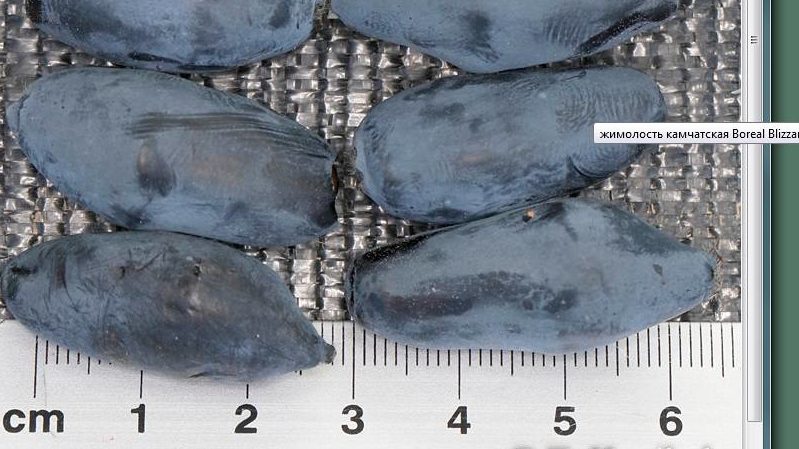
Experienced gardeners and gardeners recommend choosing varieties that are zoned for the area. You should not hope for a good harvest from bushes purchased by chance and of unknown origin.
It is more effective to plant honeysuckle in a clump (a flowerbed of several plants) so that insects can better pollinate the bushes.
There are still few reviews on the Internet; they mainly discuss the quality of the berries.
Zulfiya, Ufa: “The variety has really large and sweet berries, but I would call the variety more industrial. I don’t notice the characteristic aroma of honeysuckle.”
Roman S., Ryazan: “I dropped him off in my village in the southern part. My variety clearly did not reach the declared characteristics of the size of the berries, the weight is about 3 g. But they are dense, transportability is good. Next year I’ll plant Bist next to it for company.”
Read also:
Frost-resistant early ripening honeysuckle variety “Lakomka”
Conclusion
The unpretentious honeysuckle berry has a pleasant taste, decorative appearance and moderate growth. The modern Boreal Blizzard variety is large-fruited, has no problems with shedding, and is suitable for widespread cultivation. Requires pollinating neighbors, a sunny place, adherence to a watering regime and rare spraying against parasites and diseases.